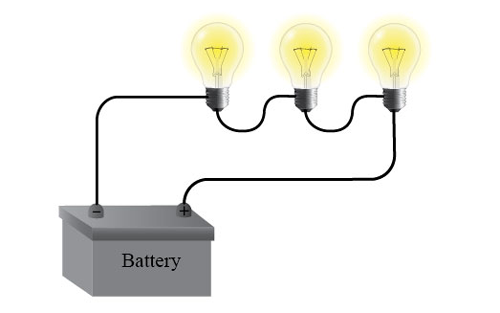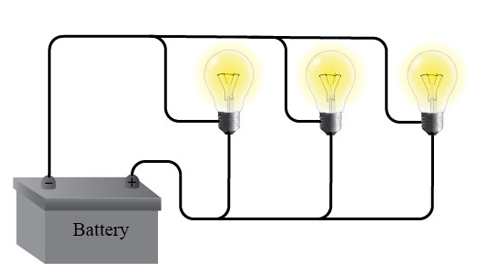Module 7 – Build an Electric Circuit
Introduction
In your reading (Sections 7.3, 7.4, and 7.5 in the text), you learned about current, resistance, voltage, and power in both series and parallel circuits. In this experiment, you will build two circuits: a series circuit with three resistors and a parallel circuit with three resistors. You will use an ammeter and a voltmeter to measure the current flow and voltage across the resistors in the circuits. After you record the results of your experiment, you will be able to compare the measurements you take with what Ohm's Law predicts the currents and voltages should be in the various circuits. You will record the data in the experiment worksheet and answer a few questions.Series Circuits
We learned in this module that the current in a series circuit depends on the total resistance (the total resistance equals the sum of the individual resistance values in the circuit) and the voltage of the power supply (in this exercise, the power supply will be a battery, and, therefore, we are dealing with a direct current (DC) circuit), according to Ohm's Law. We also learned that in a series circuit there is only one path for the current to follow. That path takes the current through each resistor in turn (in series), and the voltage across each resistor varies depending upon the value of the resistance. If all the resistors are the same value, then the voltage across each resistor is the same (IR1 = IR2 = IR3), and the sum of the voltages across all of the resistors is equal to the voltage of the power supply. If, however, the resistors all have different values, then the voltage across each resistor will be proportional to the size of the resistor in ohms. Finally, if the circuit is broken, the current will not have a path to follow, and there will be no current flowing in the series circuit. This is one of the drawbacks of dealing with a series circuit, and the reason that we use parallel circuits for distributing electricity throughout our homes.
Figure 2: Series circuit
Parallel Circuits
In a parallel circuit, the current has multiple paths to follow, and the voltage across each resistor (in parallel) will be equal to the voltage of the power supply (in this exercise, a battery, and, thus, a DC circuit). This means that the current flow through each resistor will depend on the value of the resistance. Once again, if all the resistors have the same value, the current through each resistor will be the same (I1 = I2 = I3). However, since current flow is like the flow of water in pipes of different diameters, the water will move through the path of least resistance. The same phenomenon occurs with current flow in circuits. Current will flow easier (more current) in the leg of the parallel circuit with the least resistance, and proportionally through the other legs based on the value of the resistors. For example, ifR1 > R2 > R3
, then we have the situation where I1 < I2 < I3. Finally, if the circuit is broken in one leg of the circuit, the current still flows through the rest of the circuit.

Figure 3: Parallel circuit
Procedure
You will observe the experiment performed and fill in your data sheets.1
Open the experiment instructions and worksheet.
-
•Build an Electric Circuit Instructions (HTML or PDF)
-
•Build an Electric Circuit Worksheet.
2
After you have thoroughly read the instructions and worksheet, open the experiment simulation in which you will conduct the experiment and collect your data.
3
Record your data in the worksheet. Compare to the value of voltage and current predicted by Ohm's Law. (You will need it for the experiment report assignment in WebAssign.)
